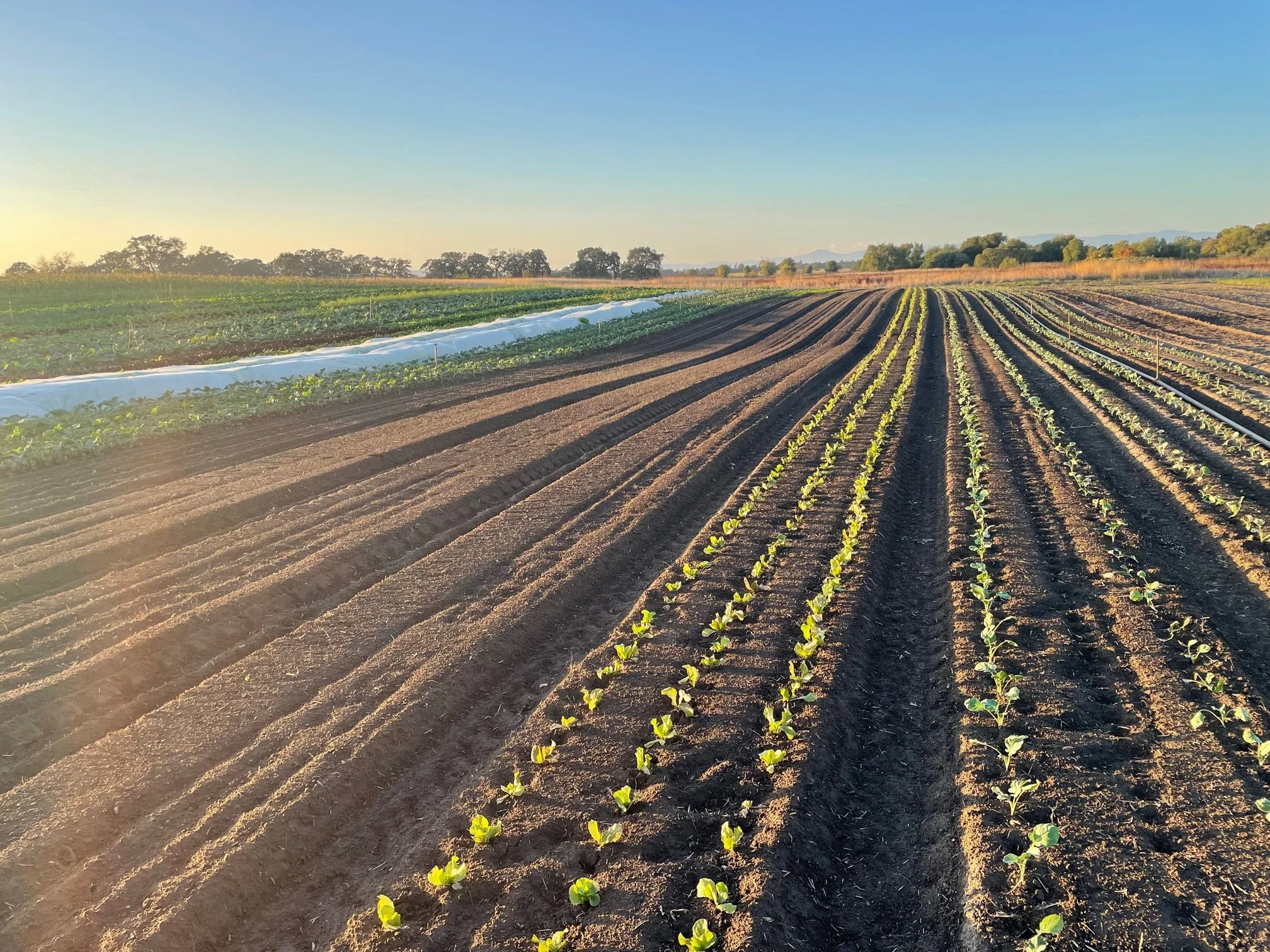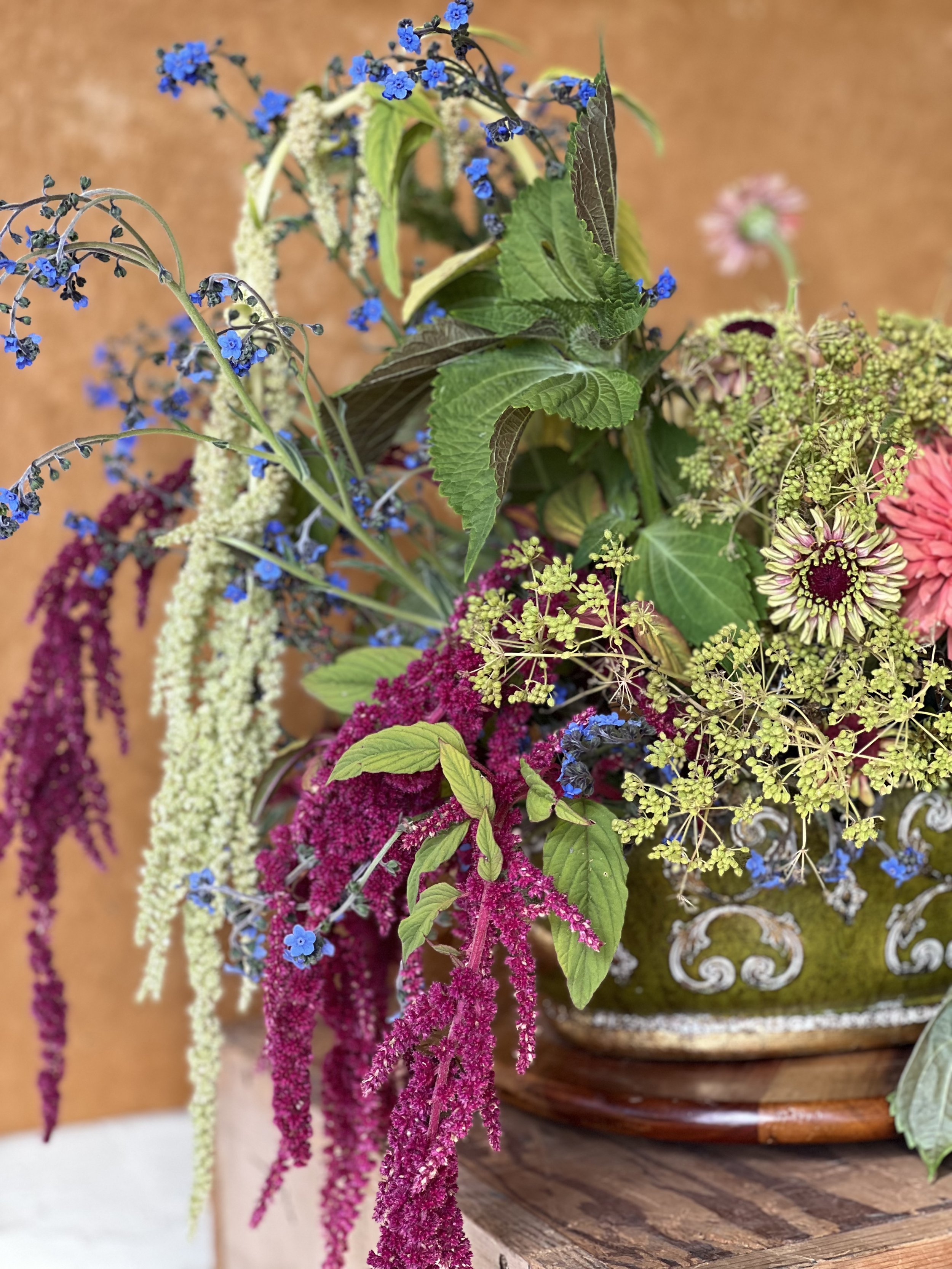THIS WEEK’S HARVEST
Newham Little Gem Lettuces, Cherokee Summer Crisp Lettuce, Sugarloaf Chicories, Red Russian Kale, Tendersweet Cabbage, Bunched Chioggia Beets, Fennel, Celery, Loose Narvik Carrots, Pickling Cucumbers, Persian & Lemon Cucumbers, Costata Romanesco & Patty Pan Squash, Fresh Elsye Onions
U-PICK
Albion Strawberries | 3 pints per share: 🚨 ATTENTION! The areas near the entrances are pretty picked on, don’t forget to branch out to the back areas to find the jack-pots!
Purple Sugar Snap Peas | 2 pints per share: As these peas fill out and get sweeter they also get more green. Look out for camouflaged green ones, which are particularly plentiful towards the back of the beds.
Padrón Peppers | 1 pint per share | See Week 4’s Newsletter for tips on how to prepare these delicacies.
Shishito Peppers | 2 pint per share | See Week 4’s Newsletter for tips on how to prepare these delicacies.
🚨 Cherry Tomatoes are on hold this week — we jumped the gun on opening up our cherry tomatoes. They need another week or two before the avalanche begins. Tomato season approaches!
Herbs: Italian, Purple and Thai Basil, Dill, Tulsi, Chamomile, Parsley, Onion Chives, Garlic Chives, Tarragon, Thyme, Oregano, Marjoram, Culinary Sage, Lemon Balm, Lemon Verbena, Vietnamese Coriander, Shiso (Perilla), Catnip, Pineapple, Sorrel, Assorted Mints
Flowers!
Sunrise over the Laguna right before seeding our big fall carrot patch.
HARVEST NOTES
Fresh Elsye Onions: Impossible to find in a grocery store, fresh onions are a vibrant farmer’s treat. They are typically more mild than their cured counterparts. Use like you would any onion, or try slicing thin and eating raw on your salads this week, or adorn your pizzas, sandwiches, or rice bowls with them.
Sugarloaf Chicories: We would die happy famers if we initiated all our CSA members into a deep and abiding love for Sugarloaf Chicories. The sweetest of the bitter chicory family, it’s delicious as a raw salad green, chopped up and paired with a rich fatty dressing (think caesar) or caramelized or roasted. To roast, cut a Sugarloaf head into quarters, coat the quarters completely with olive oil, rub in some crushed garlic, and then broil them until the outer leaves are slightly crisped and blackened the leaves are melted and soft. Then top with salt and grated parmesan and eat as a side.
Bunched Chioggia Beets: Also known as Candystripe Beets, these gorgeous pink beets have a bullseye inside and are often eaten raw to highlight their beauty and mild flavor (as in the recipe below). When cooked, the colors meld and soften into a delicate pink that is enlivened by the presence of acid like vinegar or lemon juice. See the recipe below!
Photo by Ted Cavanaugh
Crunchy Salty Lemony Salad
By Andrew Knowlton for Bon Appetite
Consider this recipe a formula where you can sub in any raw vegetable, oil, or cheese you feel like. And if you’re feeling fancy, add some crunch (nuts, seeds, or fried onions) or fresh herbs from the garden.
This week we’re thinking of fresh yellow onion, Chioggia beets, Persian cucumbers, fennel and purple basil!
Ingredients
2 small Chioggia (candy-stripe) beets, trimmed, peeled
2 Persian cucumbers
1 medium watermelon radish, trimmed
1 ounce Parmesan, Pecorino, Asiago, or other hard cheese, shaved
1 lemon
Olive oil (for drizzling)
Flaky sea salt
Freshly ground black pepper
Preparation
Very thinly slice beets, cucumbers, and radish on a mandoline or with a knife. Arrange slices on a platter. Scatter you cheese on top. Finely grate some lemon zest over salad, then slice open lemon and squeeze on some juice. Drizzle with oil; season with salt and cracked pepper.
VOLUNTEERING ON THE FARM!
Feel like getting some dirt on your hands and working in the garden with us? Send us and email! CSA member Rose Brink-Cappriola has generously offered to coordinate. We’ll send out an email and try to find a day / time that works for as many of you as possible! Kids welcome!
FARMER’S LOG
VEGGIE CHOREOGRAPHY
We had a great week out here in the fields! Asa seeded over a mile of carrots for our 3rd and final carrot patch. We transplanted Brussels sprouts for Thanksgiving and our last succession of zucchini. Char and Henry weeded our 5th of 12 lettuce successions.
Sometimes people are curious, "How do you know what to plant and when?"
Crop planning, as we call it, looks different on every farm, but here’s a little rundown of how it works at WCCF…
Working Backwards
During the winter before our first season, in December of 2016, Kayta and I worked backwards from sketches of the harvest shares we want to have for CSA members over that spring, summer, and fall. It went something like…
“Well, we gotta have alliums every week. What’s life without alliums?”
“And snack crops! The kiddos gotta have snacks!”
“Lettuce and carrots = staples.”
“Yeah, and some sort of hearty green for braising and sides.”
“And novelties to keep it fun: Corn, scapes, fennel, kohlrabi…”
“What flowers are possible in early June?”
“What are the most epic 9 Winter Squash varieties to dole out in the Fall?” Etc, etc….
From those envisioned harvests, we started spreadsheeting. Using harvest and planting logs (and memories) from seasons past regarding yields and taking into account each crop’s growth cycle, heat and frost sensitivities, yield expectations, and things like that, we could roughly deduce how many seeds to sow in the greenhouse and fields and when.
A Dance of Time Scales
When we plant seeds depends on each individual crop’s life span, or “days to maturity” in farmer lingo. For example, we like to try to have arugula and mustard greens at least twice a month every week from June-December. Arugula and mustard salad greens are super fast maturing crops (~25 days from germination to harvest) so this year we’ll sow about 1,600 ft of arugula every month from May 8th until September 25th. Carrots, on the other hand, take 75-90 days to mature. They also have a much larger harvest window (meaning they grow slow and keep well in the soil, so we can harvest off the same planting for over a month). So for carrots we sow 3 larger blocks, the first on April 24th (ideally), and the last in mid-July (yesterday!), and that gives us fresh bunched and loose carrots all the way until mid-December. On the long end of the spectrum are crops like our Floriani Flint Corn, Jack-O-Lantern Pumpkins and Winter Squash. These crops we seed once in the late-Spring, they take all summer to mature, and we‘ll harvest and enjoy them in the fall.
And so it goes that each Spring we embark with a neat greenhouse sowing and field planting spreadsheet — a musical score. This spreadsheet then becomes the drum-beat of our weeks, shape our to-do lists, and eventually become the harvest shares you see each week!
At left, Kayta checking on the onions in the greenhouse May 8th and at right those same onions yesterday morning growing strong and starting to bulb up out in Farfield!
Rubber Hits the Road
Harvest is when the real work of crop planning — the note taking and record keeping — begins. What actually happened that first year in 2017? How many bed-feet of cabbage were transplanted? How much cabbage did we harvest and how much did people take home? Was it enough? Was it too much? How did that variety hold up to the heat of July? Some things we don’t need to take notes on, like Sarah’s Choice Cantaloupe being the best melon of all time. We remember that one.
Record keeping is key. After every CSA pick-up we record how much people took home of various crops. Kayta uses those records from previous year’s pickups to determine how much to harvest each morning, and to hone how much we plant in following years.
Indeed, the most sacred objects on the farm are our harvest logs and crop planning spreadsheets (and the dirty old binder that lives in the truck labeled “Planting Log”). These are our memories, forever being honed and amassed, logs of 8 seasons of successes and failures that we will continue to refine, year by year, and that will help us, each winter, to create a planting plan ever more custom tailored to this soil, this microclimate, and this CSA.
Painting with Seeds
But the “art” of crop planning for us is in taking all of this business and planting for harvests in a way that harmonizes with the seasons, surprises, delights, and helps CSA members fall in love with food and flowers every week.
If everything goes to plan this year, for example, you should experience a seasonal arc of alliums. The fresh garlic and delicate scallions of our early harvests are now giving way to the first bulbed fresh onion bulbs of summer which will in turn give way to the solid, crispy-paper-cured orbs of late Summer and Fall. In this way we hope our allium crop plan, and our whole crop plan, inspires you.
They say, "If you want to make God laugh, make a plan." But with our amazing crew and a little bit of luck, it’s looking like we will pull off our 60 column, 230 row “2024 Crop Plan” Google sheet!
See you in the fields,
David
CSA BASICS
Still need an orientation? Please contact us by email with a few days notice to set up a time for an orientation tour. We are available for tours during Tuesday CSA pickups from 1-6 pm and Saturday CSA pickups from 9 am - 2 pm.
No dogs: Unfortunately, dogs are not allowed on the farm.
Drive slow! Please drive slow on Cooper Rd. and in our driveway / parking lot area. Kids at play!
What time is harvest pick-up?:
Saturday harvest pick-ups run from 9:00 am - 2:00 pm
Tuesday harvest pick-ups will run from 1:00 pm - 6:00 pm
Oriented members can come to the farm any time, 7 days a week, sunrise to sunset, to u-pick and enjoy the farm.
Where is the farm? The member parking lot is located at 1720 Cooper Rd., Sebastopol, CA 95472.
Where is the food? The produce pick-up barn is just to the right of the solar panels and above our big greenhouse. You can’t miss it!
2024 CSA program dates: Our harvest season will run from Saturday, June 15th through Tuesday, December 10th this year.











